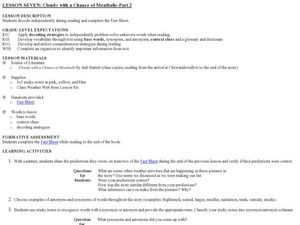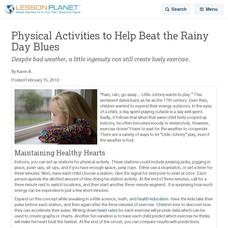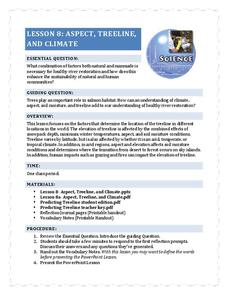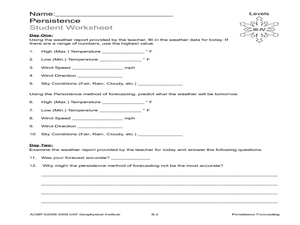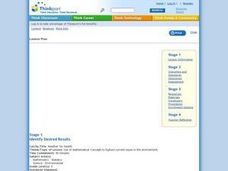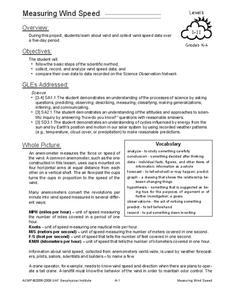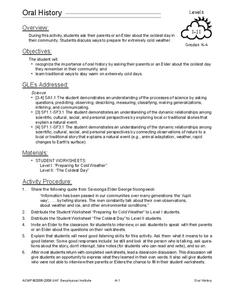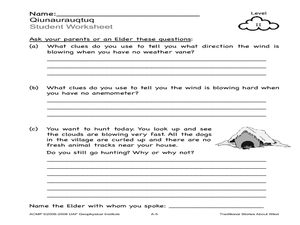Curated OER
Cloudy with a Chance of Meatballs - Part 2
Students recognize synonyms and antonyms. In this reading strategies lesson, students use the book Cloudy with a Chance of Meatballs by Judi Barrett to make predictions, and correctly recognize synonyms and antonyms.
Curated OER
Moist Air & Clouds
Fifth graders study the weather and water cycle of clouds. For this water cycle lesson, 5th graders read background information about evaporation, condensation, and the states of water.
Curated OER
Lake Ice Out Lessons
Students explore the greenhouse effect. For this environment lesson, students describe how "ice out" affects animals and plants who live in a Maine lake. Students graph "ice out" data and make predictions about the upcoming...
Curated OER
Future
In this future learning exercise, students review and discuss how to make predictions and plan events for the future. They place nine sets of words into the correct order to build nine sentences. They finish by correctly completing...
Science 4 Inquiry
An Investigative Look at Florida's Sinkholes
In May of 1981, the Winter Park Sinkhole in Florida first appeared and is now referred to as Lake Rose. Scholars learn about the causes of sinkholes through an inquiry project. Then, they analyze recent data and draw conclusions to...
Curated OER
Cloudy With a Chance of Meatballs-Part I
Here is a lesson plan that gives learners a chance to practice using context clues. They read the story, Cloudy with a Chance of Meatballs. Students use different word strategies (base words, synonyms, antonyms) to decode and understand...
Curated OER
How to Beat the Rainy Day Blues
With a little ingenuity, lively exercise can occur despite the weather.
National Park Service
Aspect, Treeline, and Climate
Head to the treeline and beyond to examine how this feature of the landscape affects weather and climate, which gives scientists clues about its health. Class members' observations of photographs provide the data...
EngageNY
Tracing the Idea of Fish Depletion: Chapter 1
Would you, could you? Scholars read World without Fish and focus carefully on the use of the words could and would. They chunk the text into smaller sections and write annotations on sticky notes to help with comprehension. To...
Curated OER
Winter Wonderland - Winter Olympics and the Water Cycle
After a concise introduction to the water cycle, junior meteorologists access NOAA's average snowfall data. They choose a city to examine in terms of precipitation. Then they look at historical snowfall data and use it to predict snow...
Curated OER
Persistence Forecasting
Learners study weather forecasting. In this weather instructional activity, students explore forecasting weather methods and do a forecast. Learners study weather reports and discuss the elements of a forecast. Students study the method...
Curated OER
Forecasting the Weather
In this weather worksheet, students will determine what a meteorologist is and the ways scientists are currently experimenting with to control the weather. This worksheet has 4 short answer questions.
Curated OER
Create Your Own Cloud
Learners explore and analyze weather conditions, climates, compositions and characteristics of the atmosphere and weather patterns. They explain in detail the water cycle and its relationship to weather patterns. A lab experiment is...
Curated OER
Weather Journals
Learners check and record the weather first thing each morning in their weather journals.
Curated OER
Tracking the Weather
Students use satellite imagery and forecasting maps as a storm moves through the United States. In this weather lesson plan students track storm systems and chart the systems on a map.
Curated OER
Weather for Health
Ninth graders encounter various types of numerical information (represented in multiple ways), much of which is abstract and difficult to comprehend. In this activity, 9th graders will convert given information into bar graphs. In the...
Curated OER
Barometer Investigation
Learners construct a barometer to use in an experiment that they design to measure the air pressure on a daily basis. These observations of air pressure allow students to determine how weather is affected when a storm is approaching and...
Curated OER
Measuring Wind Speed
Young scholars study wind speed and collect wind speed data. In this wind speed lesson, students visit a website to learn about the local wind speed forecast for their week. Young scholars discuss wind and wind speed. Students collect...
Curated OER
Oral History
Students interview a Native Elder to learn about oral history and cold weather. In this weather lesson, students ask an Elder about the coldest day they remember in their community and complete two worksheets for the topic.
Curated OER
Climate Change
In these science worksheets, 5th graders explore aspects of weather and recycling. In the first worksheet, students are given five questions about weather which they match to the statement about weather that corresponds to it. In the...
Curated OER
Fronts
Fourth graders define cold and warm fronts, explain how they are formed and they ways that they affect the weather.
Curated OER
Traditional Stories about Wind
Students observe and talk about wind using no weather instruments. In this wind lesson plan, students use their senses to observe wind. They also interview an Elder about wind.
Curated OER
Creeping
Students observe, measure, and graph a model of slow down slope movement representing soil creep. This task assesses students' abilities to collect, record, and organize data, set up graph axes, plot data points, draw line graphs, apply...
Curated OER
Trade Winds
In this trade winds worksheet, students complete multiple choice questions on trade winds and how they affect the weather. Students complete 3 questions.
